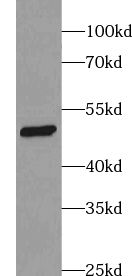Products
ZBTB18 antibody
| Synonyms: | Zinc finger and BTB domain-containing protein 18|58 kDa repressor protein|Transcriptional repressor RP58|Translin-associated zinc finger protein 1 (TAZ-1)|Zinc finger protein 238|Zinc finger protein C2H2-171|ZBTB18|RP58|TAZ1|ZNF238 antibody | ||
| Catalogue No.: | FNab09671 | Reactivity: | Human, Mouse, Rat |
| Host: | Rabbit | Tested Application: | ELISA, WB, IP, IHC |
| Clonality: | polyclonal | Isotype: | IgG |
| Size | Price |
|---|---|
| 100µg | Inquiry |
- SPECIFICATIONS
- FIGURES
- CONDITIONS
- FAQS
- Product Name
- ZBTB18 antibody
- Catalogue No.
- FNab09671
- Size
- 100μg
- Form
- liquid
- Purification
- Immunogen affinity purified
- Purity
- ≥95% as determined by SDS-PAGE
- Clonality
- polyclonal
- Isotype
- IgG
- Storage
- PBS with 0.02% sodium azide and 50% glycerol pH 7.3, -20℃ for 12 months(Avoid repeated freeze / thaw cycles.)
- Immunogen
- zinc finger protein 238
- Alternative Names
- Zinc finger and BTB domain-containing protein 18|58 kDa repressor protein|Transcriptional repressor RP58|Translin-associated zinc finger protein 1 (TAZ-1)|Zinc finger protein 238|Zinc finger protein C2H2-171|ZBTB18|RP58|TAZ1|ZNF238 antibody
- UniProt ID
- Q99592
- Observed MW
- 48 kDa
- Tested Applications
- ELISA, WB, IP, IHC
- Recommended dilution
- WB: 1:500-1:5000; IP: 1:500-1:5000; IHC: 1:20-1:200
 mouse brain tissue were subjected to SDS PAGE followed by western blot with FNab09671(ZNF238 antibody) at dilution of 1:1000
mouse brain tissue were subjected to SDS PAGE followed by western blot with FNab09671(ZNF238 antibody) at dilution of 1:1000
 IP result of anti-ZNF238 (FNab09671 for IP and Detection) with mouse cerebellum tissue.
IP result of anti-ZNF238 (FNab09671 for IP and Detection) with mouse cerebellum tissue.
 Immunohistochemistry of paraffin-embedded mouse brain tissue slide using FNab09671(ZNF238 Antibody) at dilution of 1:50
Immunohistochemistry of paraffin-embedded mouse brain tissue slide using FNab09671(ZNF238 Antibody) at dilution of 1:50
- Background
- ZNF238 is a member of the BTB/POZ-ZF protein family, which involve in development and cancer formation, for example BCL-6, PLZF, and HIC-1. It's a transcriptional repressor involve in myogenesis and brain development. By directly repressing the expression of two skeletal myogenesis inhibitors, ID2 and ID3, ZNF238 plays a key role in myogenesis. It can control cell division of progenitor cells and regulating the survival of postmitotic cortical neurons. Besides, ZNF238 involves in the organization of nuclear chromosomes, for its specific binding to the consensus DNA sequence that contains the E box core, and recruiting chromatin remodeling multiportein complex. ZNF238 proteins has apparent molecular masses of 60 and 48 kD. Specific binding is found for a 60-kDa band which corresponds to the full length of RP58 protein. In addition, a 48-kDa band, thought to be the truncated form 2 is detected(PMID: 9756912).
How many times can antibodies be recycled?
First, usually it's not suggested to recycle antibodies. After use, buffer system of antibodies has changed. The storage condition of recycled antibodies for different customers also varies. Thus, the performance efficiency of recycled antibodies can’t be guaranteed. Besides, FineTest ever conducted the antibody recycling assay. Assay results show recycling times of different antibodies also varies. Usually, higher antibody titer allows more repeated use. Customers can determine based on experimental requirements.
Notes: After incubation, we recycle rest antibodies to centrifuge tube and store at 4℃. High titer antibodies can be stored for a minimum of one week. Reuse about three times.
What are components of FineTest antibody buffer?
Components of FineTest antibody buffer are usually PBS with proclin300 or sodium azide, BSA, 50% glycerol. Common preservative is proclin300 or sodium azide, which is widely applied in the lab and industry.
How about the storage temperature and duration of FineTest antibodies?
Most antibodies are stored at -20℃. Directly-labeled flow cytometry antibodies should be stored at 2 - 8℃. The shelf life is one year. If after sales issues for purchased antibodies appear, return or replacement is available. Usually, antibodies can be still used after the one-year warranty. We can offer technical support services.
Is dilution required for FineTest antibodies? What’s the dilute solution?
Directly-labeled flow cytometry antibodies are ready-to-use without dilution. Other antibodies are usually concentrated. Follow the dilution ratio suggested in the manual. Dilute solution for different experiments also varies. Common antibody dilution buffers are acceptable(e.g. PBST, TBST, antibody blocking buffer).
How to retrieve antibodies for immunohistochemistry?
Common retrieval buffers: Tris-EDTA Buffer(pH 9.0); Citrate Buffer(pH 6.0)
Heat induced antibody retrieval:
Method 1: Water-bath heating: Put the beaker with retrieval buffer and slide in the boiling water bath. Keep the boiling state for 15min. Naturally cool to room temperature;
Method 2: Microwave retrieval: Put the beaker with retrieval buffer and slide in the microwave oven. Heat at high power for 5min, Switch OFF for 3min, Heat at medium power for 5min. Naturally cool to room temperature.
How to choose secondary antibodies?
(1) Secondary antibodies react with primary antibodies. Thus, secondary antibodies should be against host species of primary antibodies. E.g. If the primary antibody is derived from rabbit, the relevant secondary antibody should be against rabbit. E.g. goat anti rabbit or donkey anti rabbit.
(2) Choose secondary antibody conjugates according to the experimental type, e.g. ELISA, WB, IHC etc. Common enzyme conjugated secondary antibodies are labelled by HRP, AP etc. Fluorescin or dye labelled secondary antibodies are applied in immunofluorescence and flow cytometry(e.g. FITC, Cy3).
